Uzbekistan is somewhat of an enigma. Not as many travelers visit Central Asia so Uzbekistan and its wonders remain a mystery to many people.
But that hasn’t always been the case. There was a time when this double-landlocked nation was one of the most visited regions in the world. Thanks to its strategic position along the Silk Road, travelers and traders would go through Uzbekistan in droves, leading to cities like Samarkand and Bukhara amassing considerable wealth and power.
The Silk Road’s impact on Uzbekistan is clearly evident in the country’s jaw-dropping Islamic architecture. It can also be appreciated in its cuisine. Uzbek food is an intriguing blend of influences, shaped through the centuries by its neighbors and the many traders traveling along the Silk Road.
Food is always a fantastic way to experience the local culture. The architecture in Uzbekistan is one of the country’s biggest draws but as this list of tasty Uzbek dishes will show you, so is the food.
Save This on Pinterest!
No time to read this guide on the food in Uzbekistan? Click on the save button and pin it for later!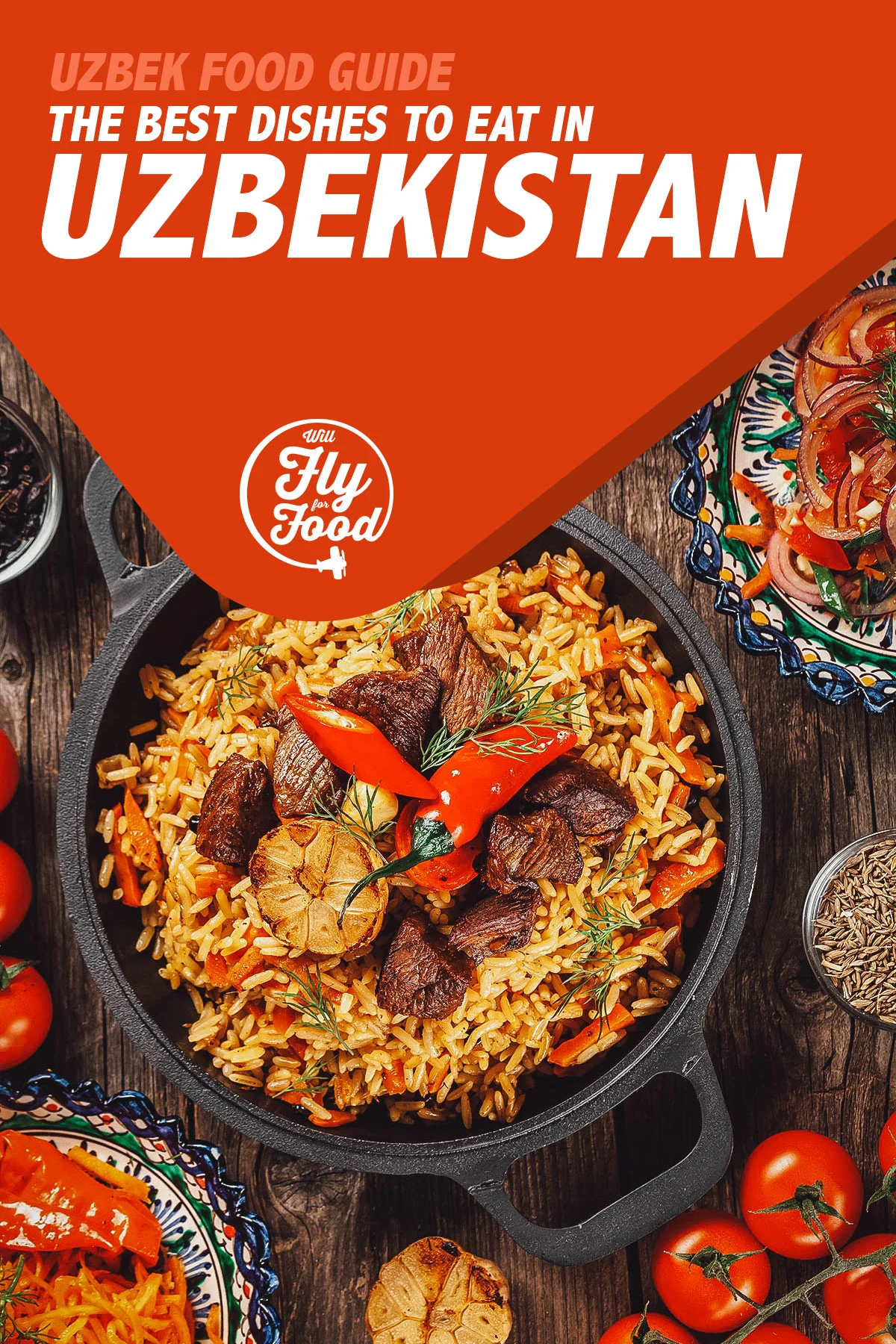
Photo by Zukamilov
WHERE IS UZBEKISTAN?
Uzbekistan is a dry, landlocked country in Central Asia. It’s bordered by Kazakhstan to the north, Turkmenistan and Afghanistan to the south, and Tajikistan and Kyrgyzstan to the east. Tashkent is its capital and largest city while Samarkand and Bukhara are two of its most popular destinations.
Aside from its position along the Silk Road, it was interesting to learn that Uzbekistan is one of just two double-landlocked countries in the world. A double-landlocked country is a country that’s bordered on all sides by other landlocked countries. Liechtenstein is the other.
WHAT IS TRADITIONAL UZBEK FOOD?
Uzbekistan shares many dishes and culinary traditions with its neighbors in Central Asia.
Freshly butchered meat and locally-grown vegetables feature prominently in the diet of local Uzbek people. Thanks to the abundance of sheep, mutton and lamb are among the most widely consumed meats. They make their way into many Uzbek recipes though beef, goat, poultry, camel, and horse meat are also common.
Being a grain-farming country, rice, noodles, and breads are equally vital to Uzbek culture and cuisine. In fact, plov or Uzbek rice pilaf is the country’s national dish and the most popular food in Uzbekistan.
THE BEST OF UZBEK CUISINE
1. Achichuk
Achichuk is a type of Uzbek salad made with fresh onions, tomatoes, chili pepper, herbs, and seasonings. Often served as a side dish with plov, it’s one of the simplest local salads you can try in Uzbekistan.
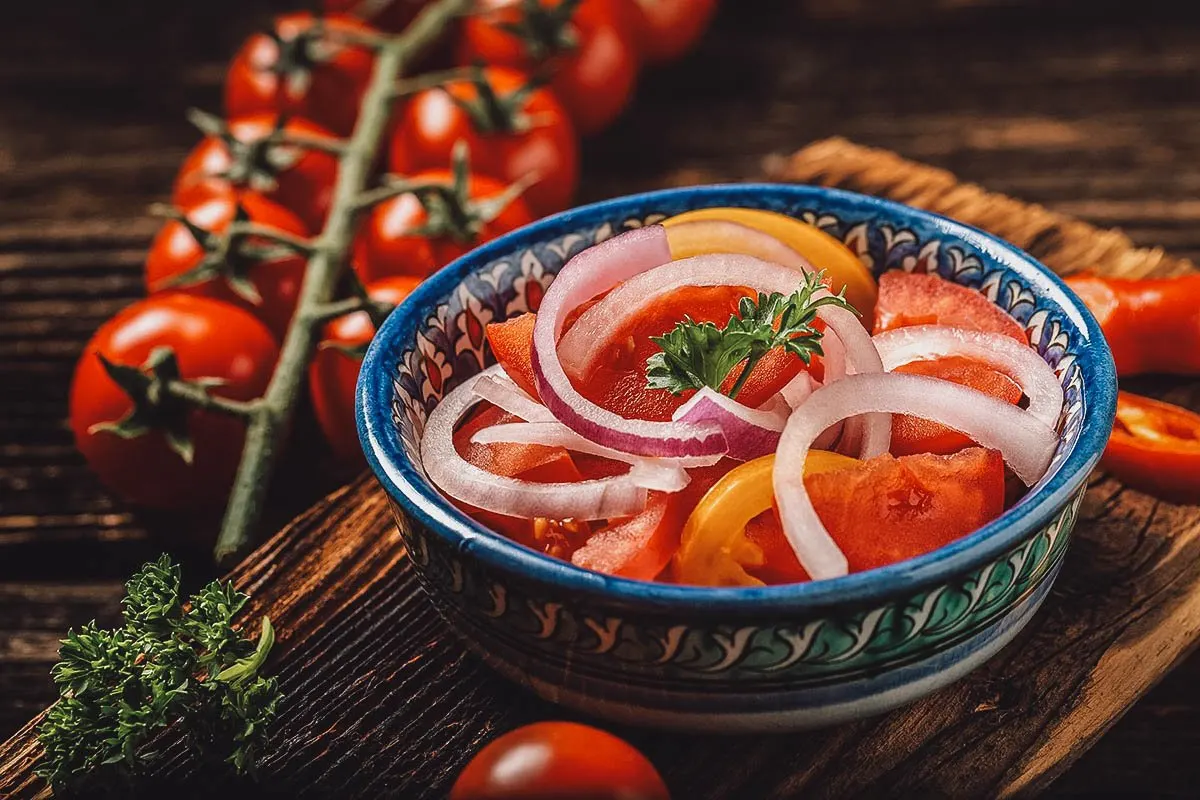
Photo by kovalnadiya.ukr.net
2. Manti
If you’re fond of dumpling dishes, then you need to try manti. It refers to a type of boiled or steamed dumpling popular in many countries throughout Central Asia, the Balkans, and the South Caucasus. Made with ground meat wrapped in thin dough, you can think of it as the Uzbek version of Chinese baozi/jiaozi, Korean mandu, Tibetan momo, or Monoglian buuz.
The size, shape, and fillings for manti can vary from region to region. In Central Asia, they’re usually larger in size and steamed using a multi-level metal steamer called a mantovarka. These large steamed dumplings are typically made with spiced minced meat like ground lamb or beef, lamb fat, potatoes, onions, cabbage, pumpkin, and other vegetables.
In Uzbekistan, manti are enjoyed for lunch or dinner, usually with sour cream, tomato sauce, or fresh sliced onions. Like many Uzbek dishes, they’re traditionally eaten by hand.
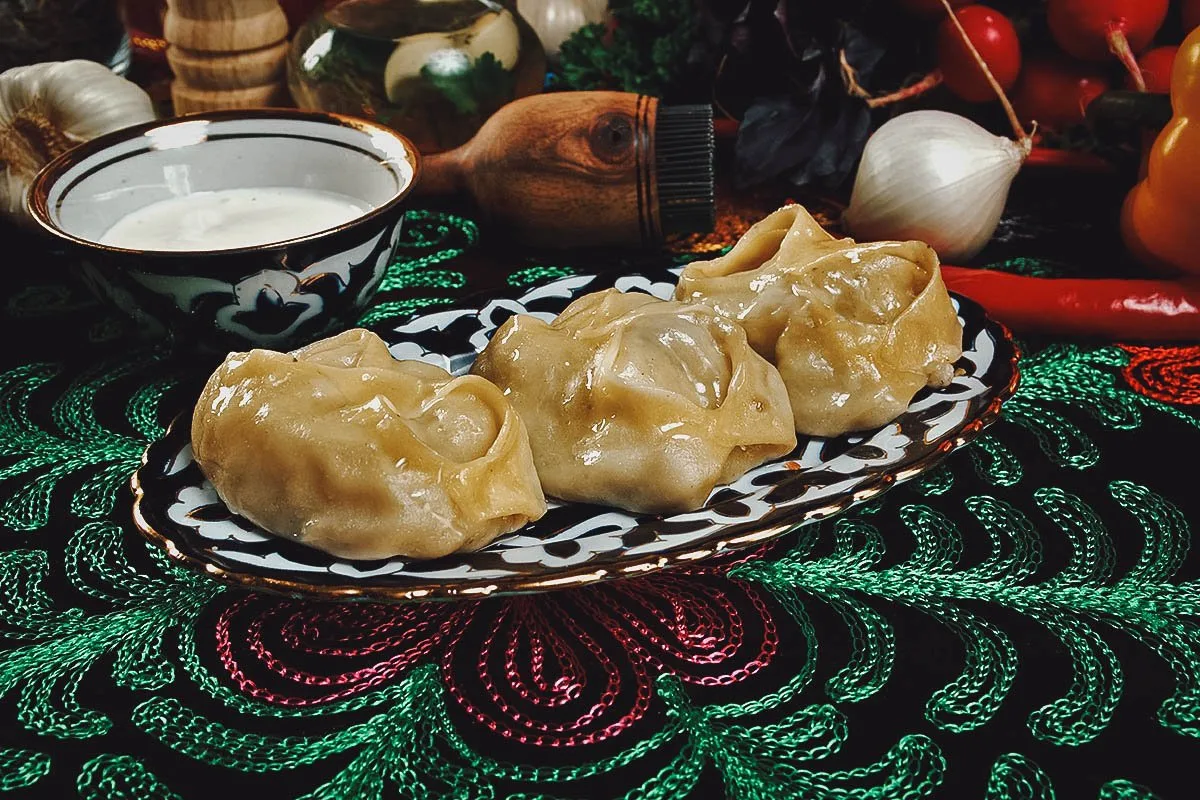
Photo by fanfon
3. Samsa
Samsa (or somsa, samosa) refers to a type of savory pastry popular in Central Asian cuisine. You can think of it as the Uzbek version of the Indian samosa and other similar iterations like the Lebanese sambousek and the Moroccan briouat.
Unlike Indian samosas that are deep-fried, samsas in Uzbekistan and Central Asia are traditionally baked in an oven. They’re commonly shaped like triangles and stuffed with a mixture of ground meat (usually lamb, beef, or chicken), tail fat, and spices. Meat samsa is the most common but you can find other versions as well like potato, pumpkin, or onion samsa.
Soft and crunchy on the outside but juicy on the inside, this flaky pastry is a staple breakfast food in Uzbekistan. It’s traditionally eaten for breakfast with tea or as a hot street food snack.
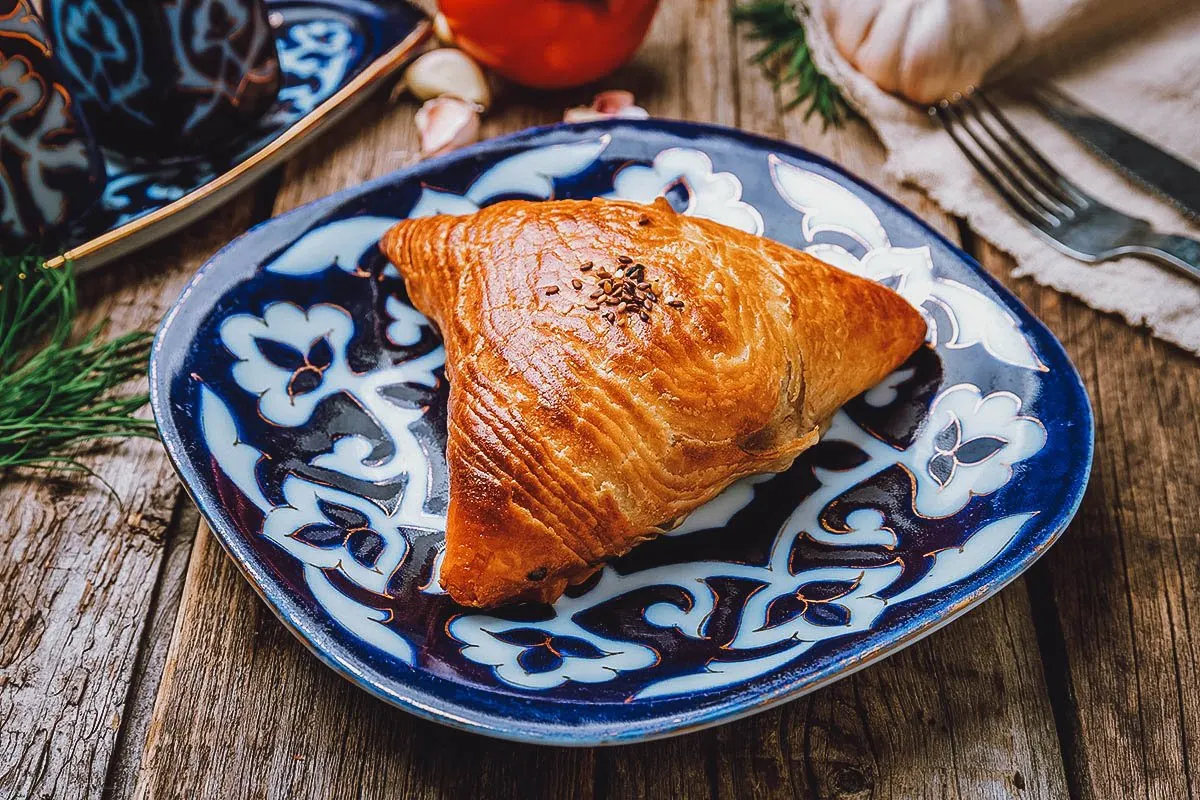
Photo by bbivirys
4. Chuchvara
Chuchvara refers to a traditional dumpling that’s sometimes referred to as the Uzbek version of Russian or Italian ravioli. It’s similar to manti except it’s smaller in size and traditionally boiled in a soup with meat and vegetables.
To make chuchvara, a basic dough is rolled out and cut into smaller squares before being stuffed with a mixture of minced meat (usually lamb or beef), onions, and seasonings. The dumplings are then boiled in broth with fried meat and vegetables. Often served with a sprinkling of fresh dill, you can think of chuchvara as the Uzbek version of Chinese wonton soup.
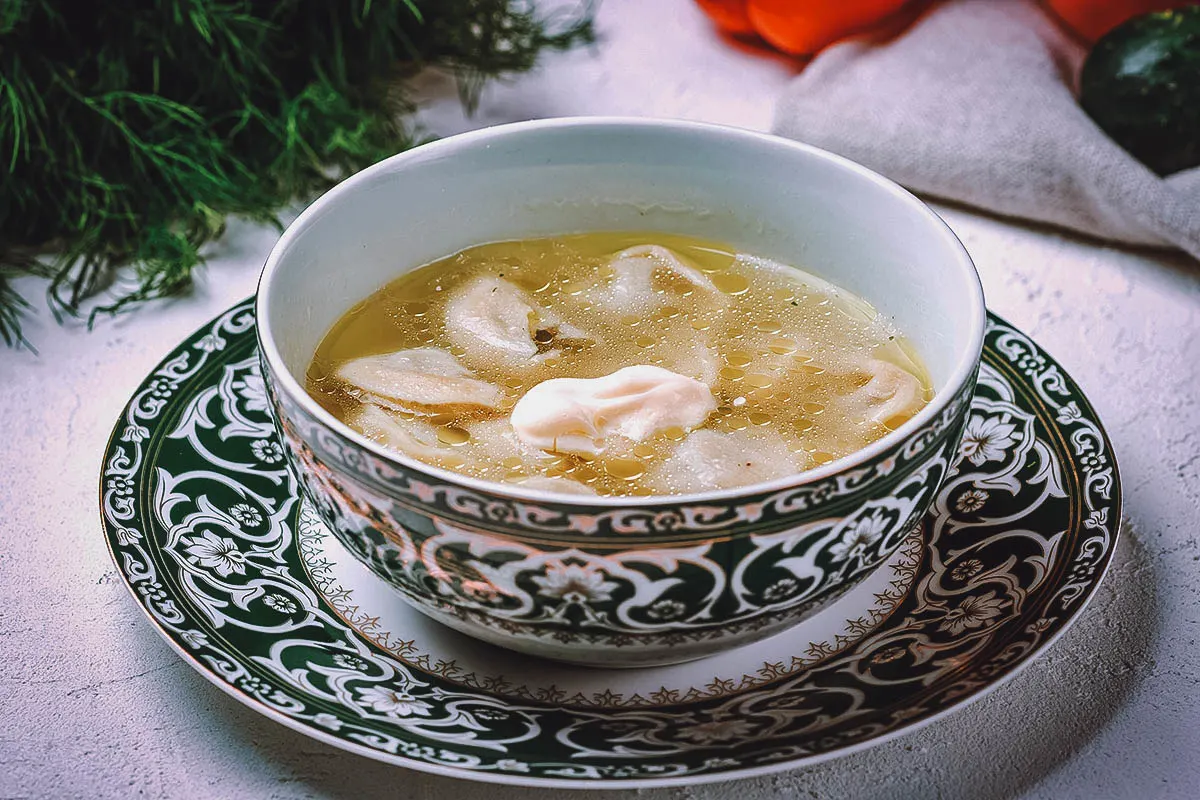
Photo by bbivirys
Chuchvara dumplings are traditionally served in soup but they can be fried as well. Kovurma chuchvara or fried chuchvara are cooked in hot oil and typically served with a side of sour cream or cold yogurt.
Other types of chuchvara in Uzbekistan include osh kuktli chuchvara and ugra chuchvara. The former is made with a stuffing of finely chopped greens, onions, tail fat, and hard-boiled eggs while the latter consists of classic chuchvara dumplings cooked in a soup with meatballs and noodles.
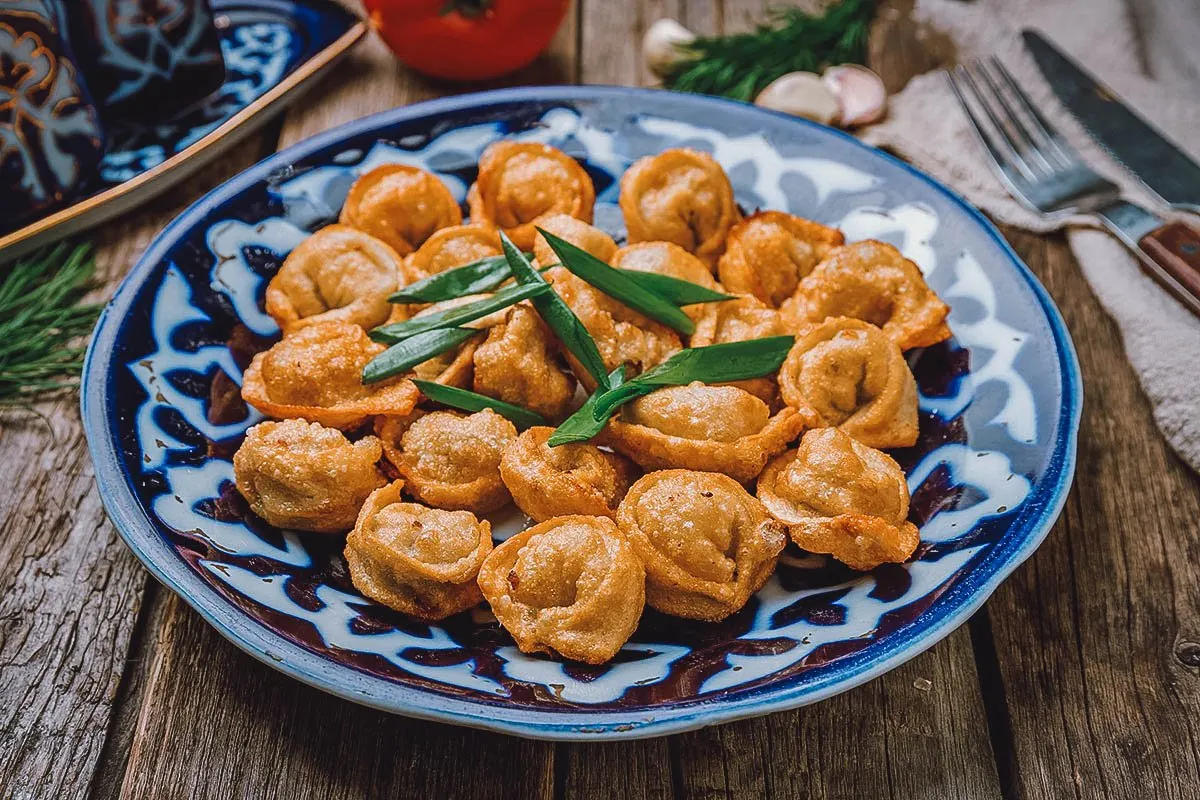
Photo by bbivirys
5. Shurpa
Shurpa (or shorba, chorba) refers to a family of soups or stews found in the cuisines of many countries throughout Central Asia, the Middle East, the Balkans, and Central/Eastern Europe. They can be made in different ways and typically consist of large chunks of meat cooked in a broth with potatoes, different vegetables, herbs, and spices.
Shurpa is a hugely popular Uzbek soup traditionally made with lamb and thick slices of potato, carrot, onion, tomato, and sweet pepper. It’s seasoned simply with salt and black pepper and often garnished with fresh dill, coriander, or parsley. Served with bread, this rich, thick soup is hearty and filling and one of the most beloved dishes in Uzbek cuisine.
Lamb soup is the most popular but there are many recipes for shurpa in Uzbekistan. It can be cooked in a number of ways and made with different ingredients like chickpeas, fish, or meatballs.
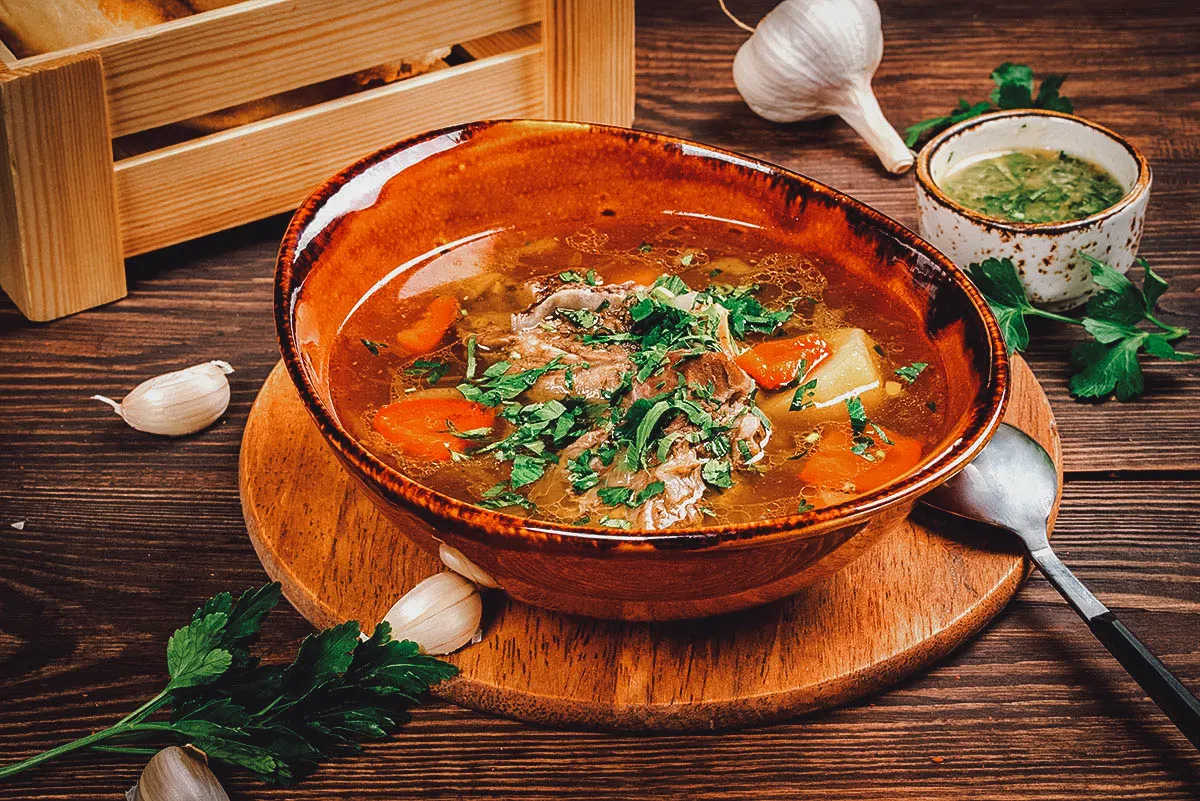
Photo by Sapunovaphoto
6. Lagman
Like plov and shashlik, lagman is one of the most popular Uzbek dishes. Originally from Xinjiang in northwestern China, it refers to a pulled noodle dish that’s become popular in many Central Asian countries like Uzbekistan, Kazakhstan, Kyrgyzstan, Tajikistan, and Turkmenistan.
In Uzbekistan, lagman is typically served in one of two ways – as a hearty noodle stew or as a fried noodle dish. When served as a soup, the hand-stretched noodles are boiled in water and served in a rich broth made with fried meat (usually lamb or beef), garlic, onions, potatoes, carrots, bell peppers, and other vegetables. It’s typically seasoned with cumin seed, salt, and pepper before serving.
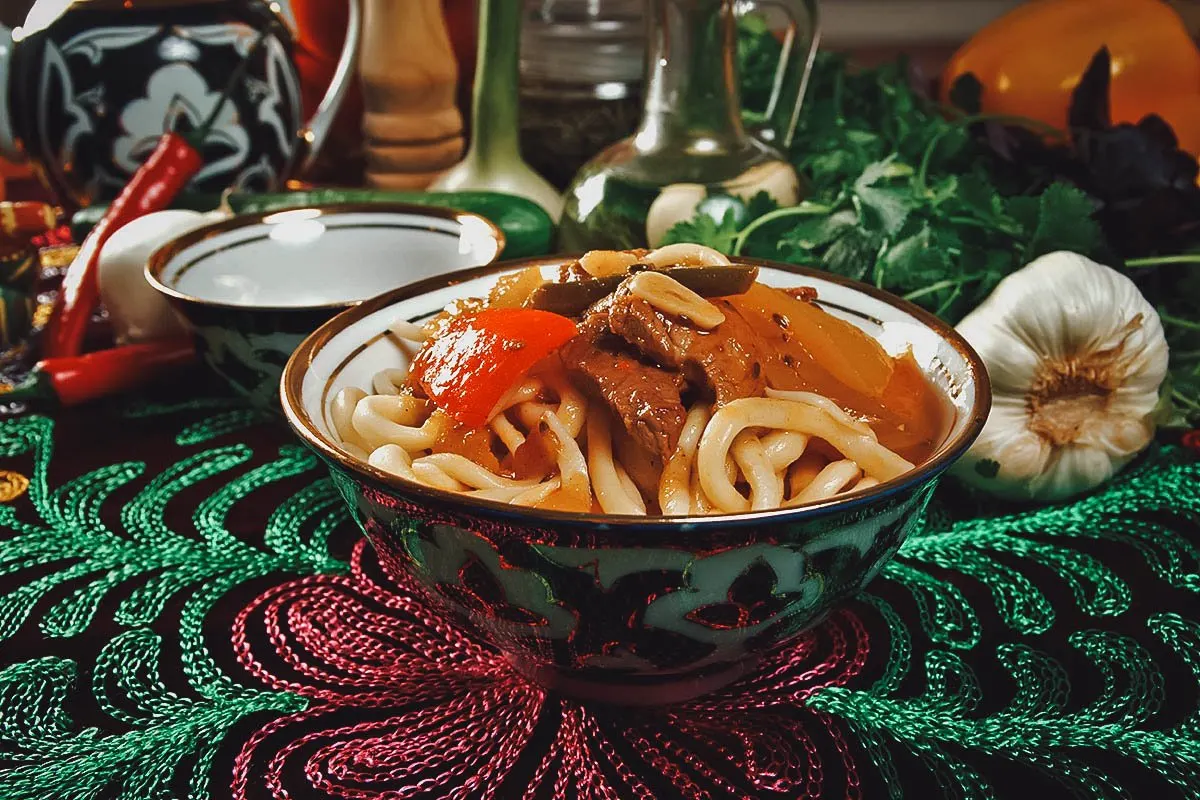
Photo by fanfon
Also popular in Uzbekistan is fried lagman. It consists of stir-fried lagman noodles cooked in a vegetable sauce made from garlic, onions, bell peppers, carrots, potatoes, herbs, and other ingredients. It can be served on its own or topped with a fried egg.
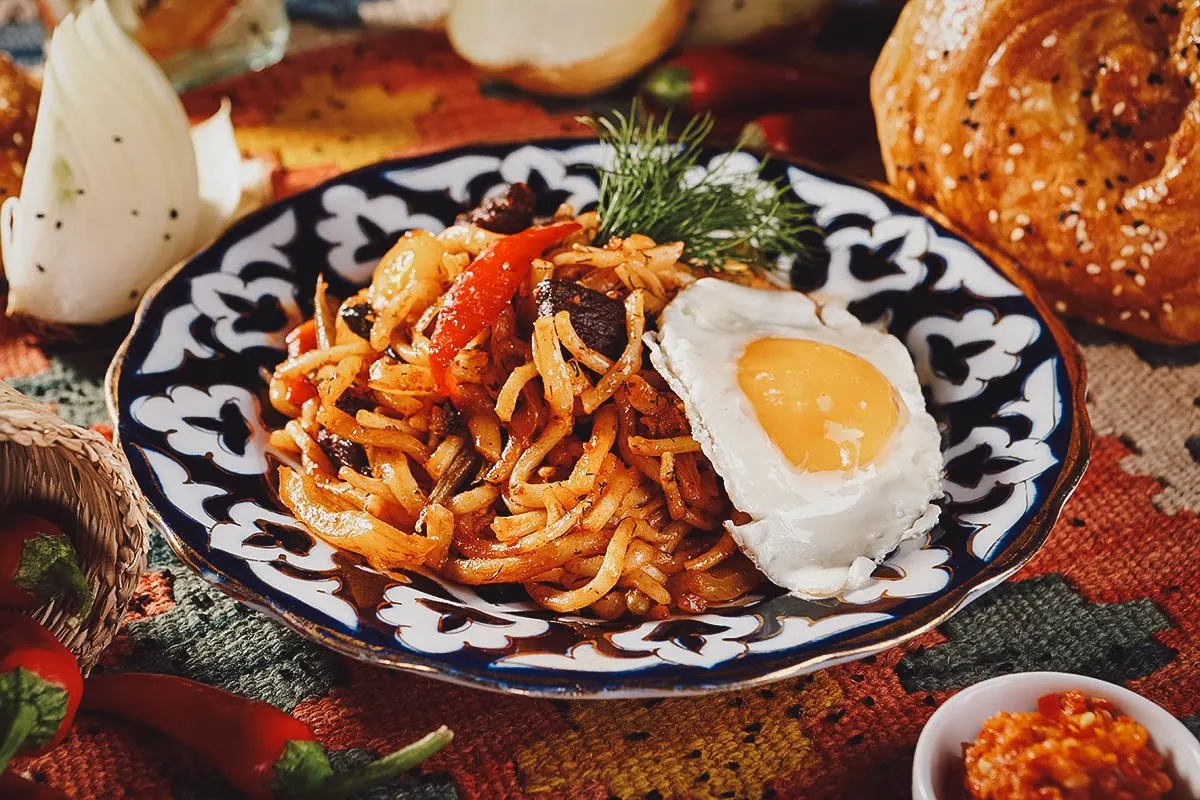
Photo by ryzhkov86
7. Shivit Oshi
Shivit oshi is one of the most eye-catching Uzbek dishes on this list. Also known as “khorezm lagman”, it’s a colorful dish of bright green noodles from Khiva, an Uzbek city near the border with Turkmenistan.
Khorezm cuisine differs in many ways from the rest of Uzbekistan. Fresh herbs and vegetables feature more prominently in the diet and the best example of this is shivit oshi. It’s a regional Uzbek dish made with hand-pulled lagman noodles infused with fresh dill, giving them their characteristic bright green coloration.
Mainly a summer dish and served only in Khiva, shivit oshi is must-try food in Uzbekistan. It’s traditionally enjoyed topped with a meat and vegetable stew and a side of sour cream or plain yogurt.
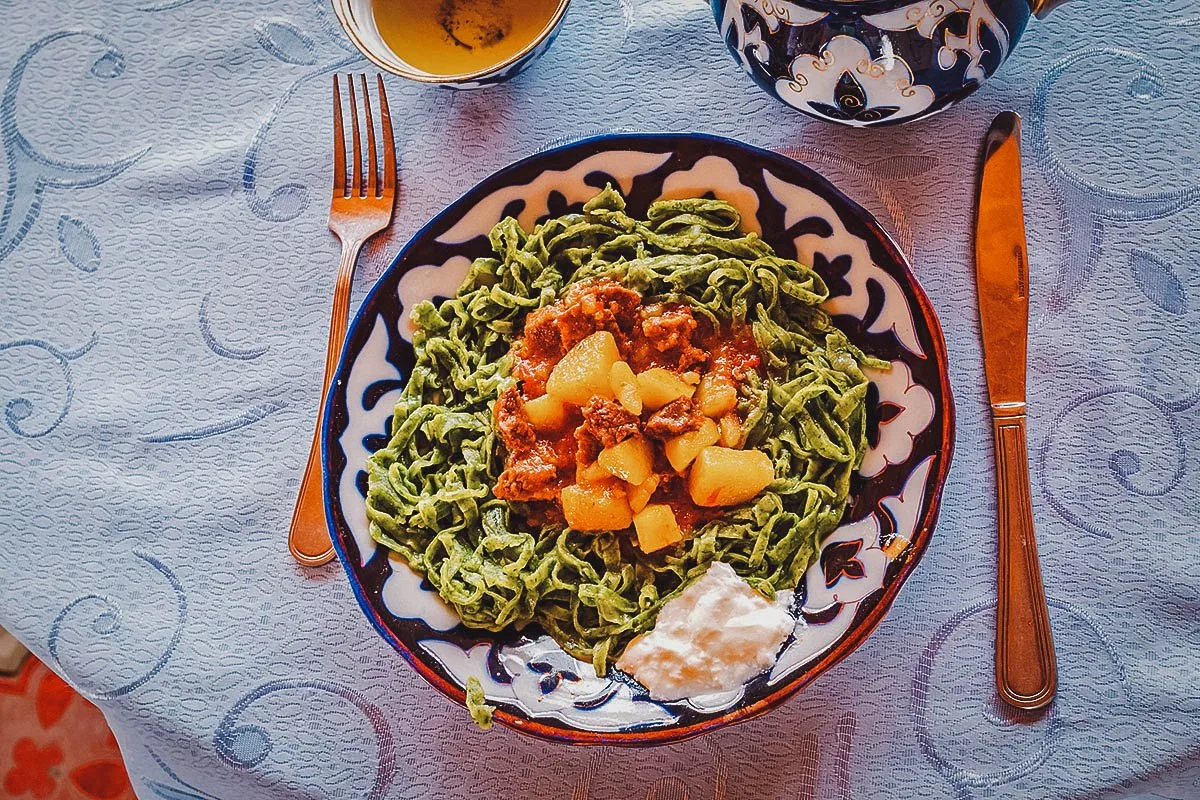
Photo by efesenko
8. Obi Non
Like plov, obi non is one of the most important foods in Uzbekistan. Also known as lepyoshka, it refers to a type of round, flat Uzbek bread baked in a traditional clay oven called a tandyr. You can think of it as the Uzbek version of Indian naan bread, but thicker and adorned with a decorative top.
This ubiquitous homemade bread is eaten with just about anything in Uzbekistan. It can be made in many ways and varies from region to region, even from town to town! It can be plain or enriched with additional ingredients like meat, lamb fat, nuts, sesame seeds, and raisins.
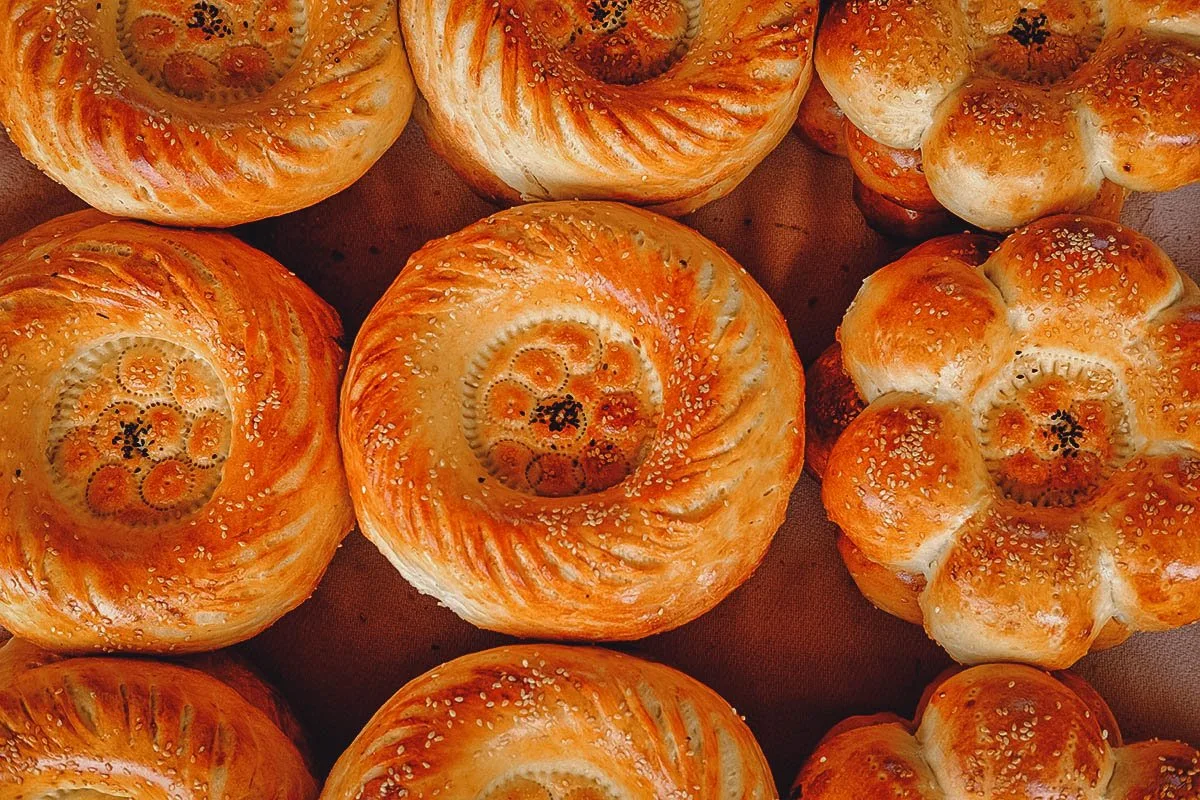
Photo by omnislash
9. Plov
No article on Uzbek food can ever be complete without plov, the country’s national dish. It refers to the Uzbek version of hearty rice pilaf, a widely consumed dish of rice cooked in broth that originated in South Asia, Central Asia, and the Middle East.
Plov (or palov) is the most famous dish in Uzbekistan. It’s a socially and culturally important food that Uzbeks are abundantly proud of. Traditionally prepared in a kazan (large cooking pot), plov is commonly made at home as a family meal or in larger quantities to celebrate holidays and special occasions like weddings.
Uzbek plov can be made in dozens of ways, but the most famous version is made with a base of grated and seasoned onions, carrots, and meat sautéed in fat. Rice is added before being topped with water and simmered until the rice is fully cooked. Depending on the cook, different ingredients can be added as well like meat, chickpeas, vegetables, raisins, and fruit.
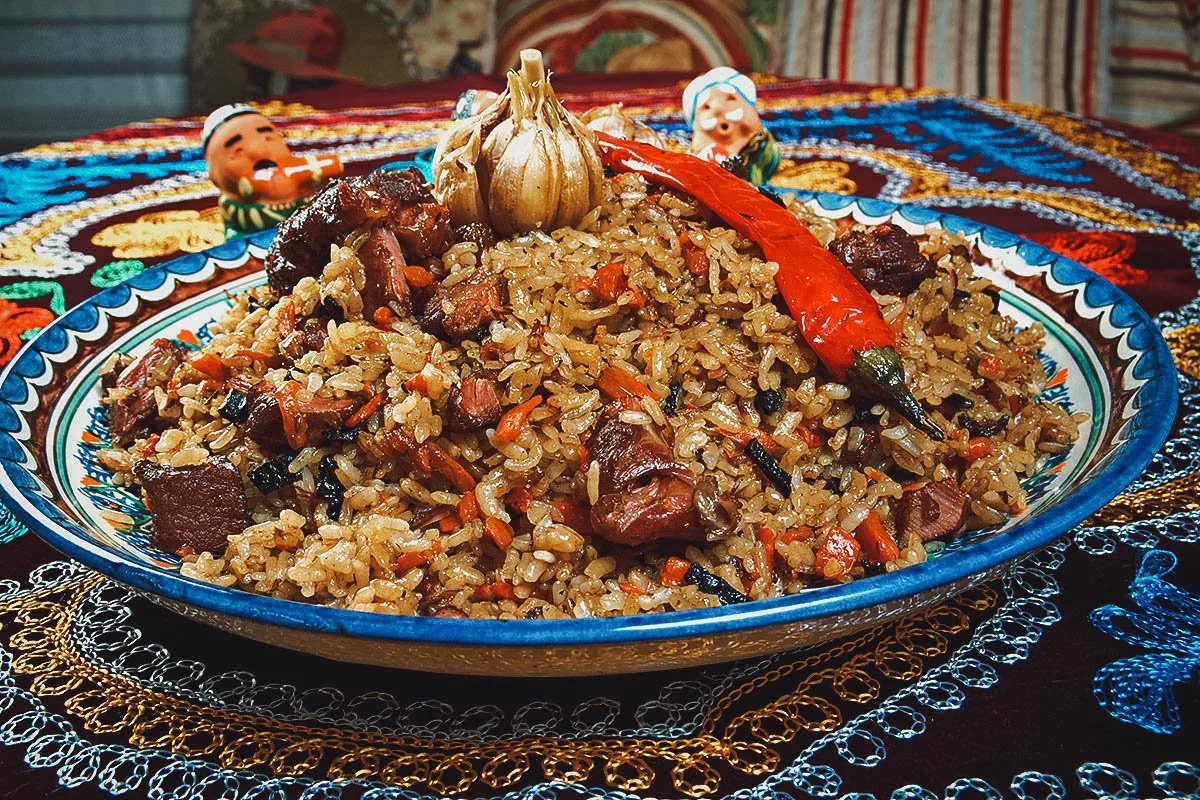
Photo by fanfon
10. Shashlik
If you like meat dishes, then you need to try shashlik. It’s one of the most popular dishes in Uzbek cuisine and refers to a version of shish kabob that’s consumed in many countries throughout Central Asia, the Caucasus, and in former Soviet Republics like Uzbekistan, Georgia, Armenia, Lithuania, and Ukraine. In fact, the word shashlik stems from shashlyk, the Russian word for “shish kabob”.
Shashlik is traditionally made with lamb but it can be made with other types of meat as well like beef, chicken, and venison. Meat rolls made with ground beef or fatty beef (or lamb) are common, as are skewered and grilled chicken legs. For a truly memorable experience, then you may want to order grilled skewers threaded with horse meat.
Whatever it’s made with, shashlik skewers are typically threaded with just meat or with alternating pieces of meat, fat, mushrooms, and vegetables. If you prefer vegetarian food, then you can order grilled skewers of just potatoes, vegetables, or mushrooms as well.
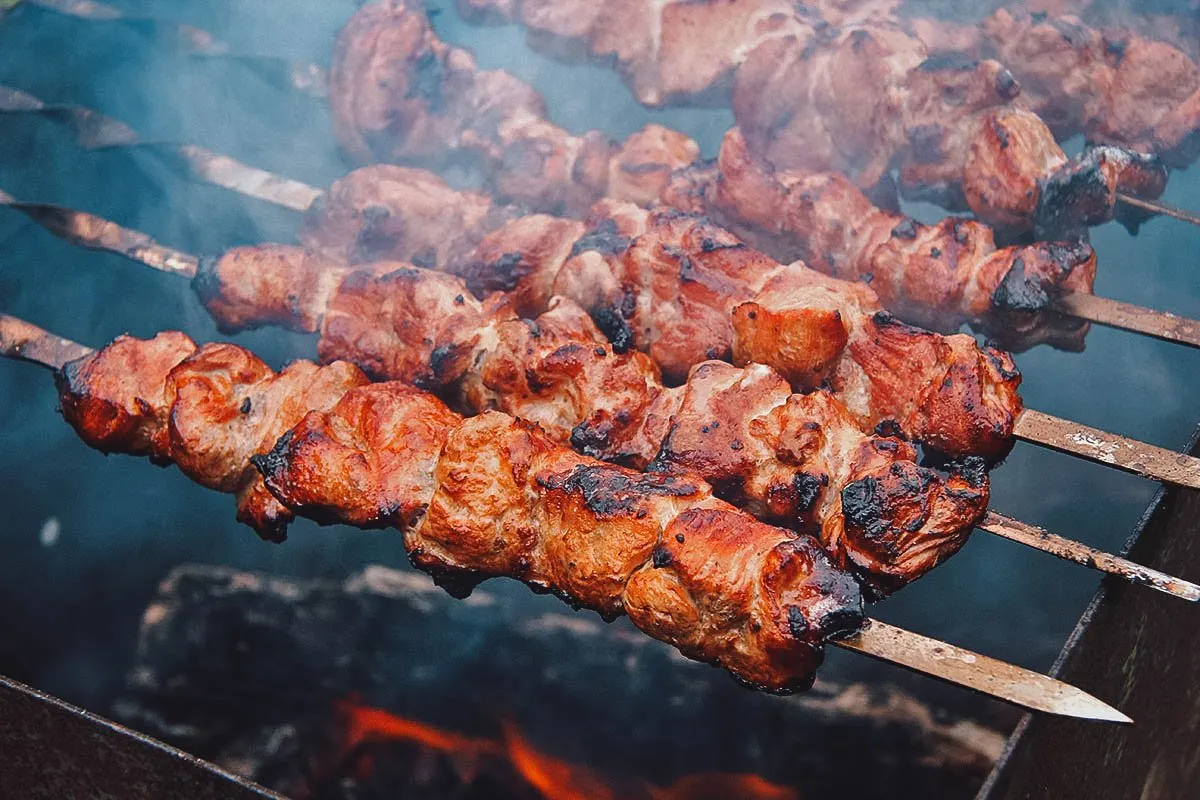
Photo by rovada
11. Kazan Kabob
As its name suggests, kazan kabob is an Uzbek dish traditionally prepared in a kazan, a large cooking pot commonly used in Central Asian and Balkan cuisines. The kazan is the same pot used to make plov.
Kazan kabob isn’t like your typical kabob dish. It consists of marinated meat like mutton or beef that’s pan-fried first with potatoes before being covered and steamed in a kazan at low heat. When fully cooked and tender, it’s traditionally served with onions and fresh vegetables.
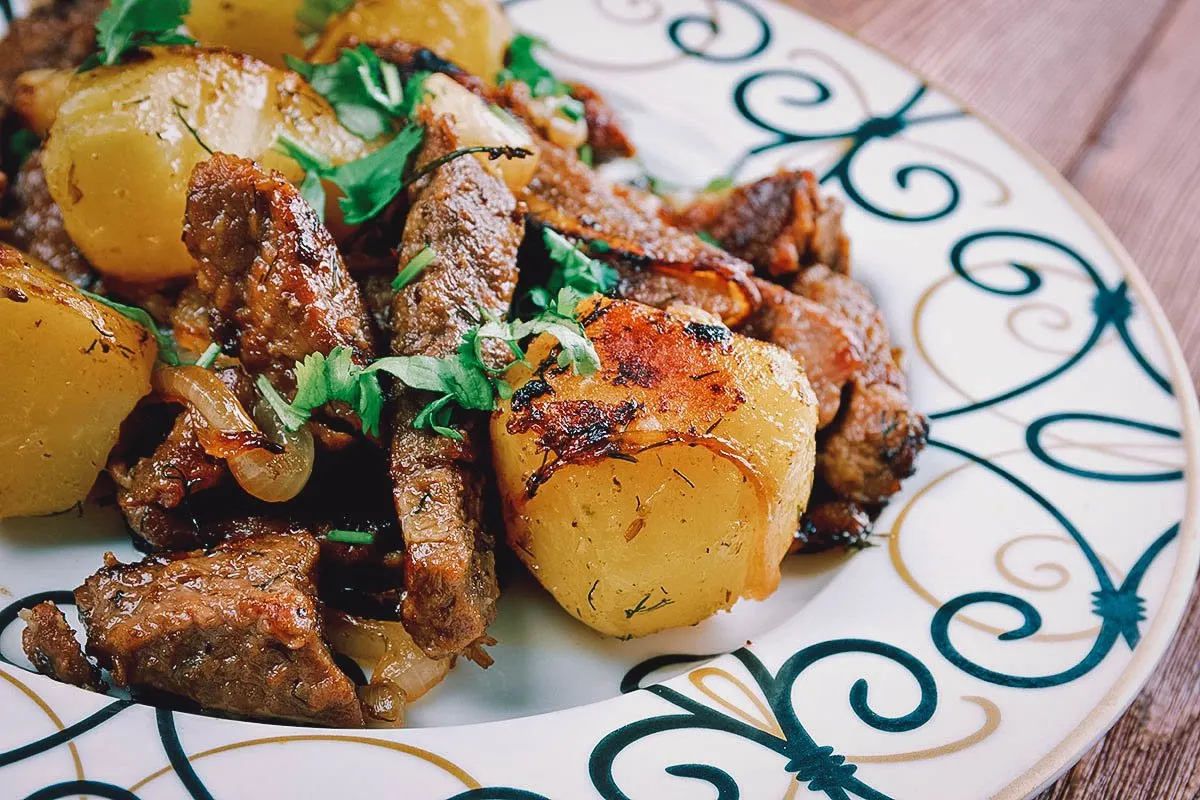
Photo by fanfon
12. Dried Nuts and Fruits
Like many countries in the region, dried nuts and fruits are common in Uzbekistan. They can be found at every food market and make for an interesting snack or healthy dessert. Toasted apricot seeds are especially popular and often paired with beer.
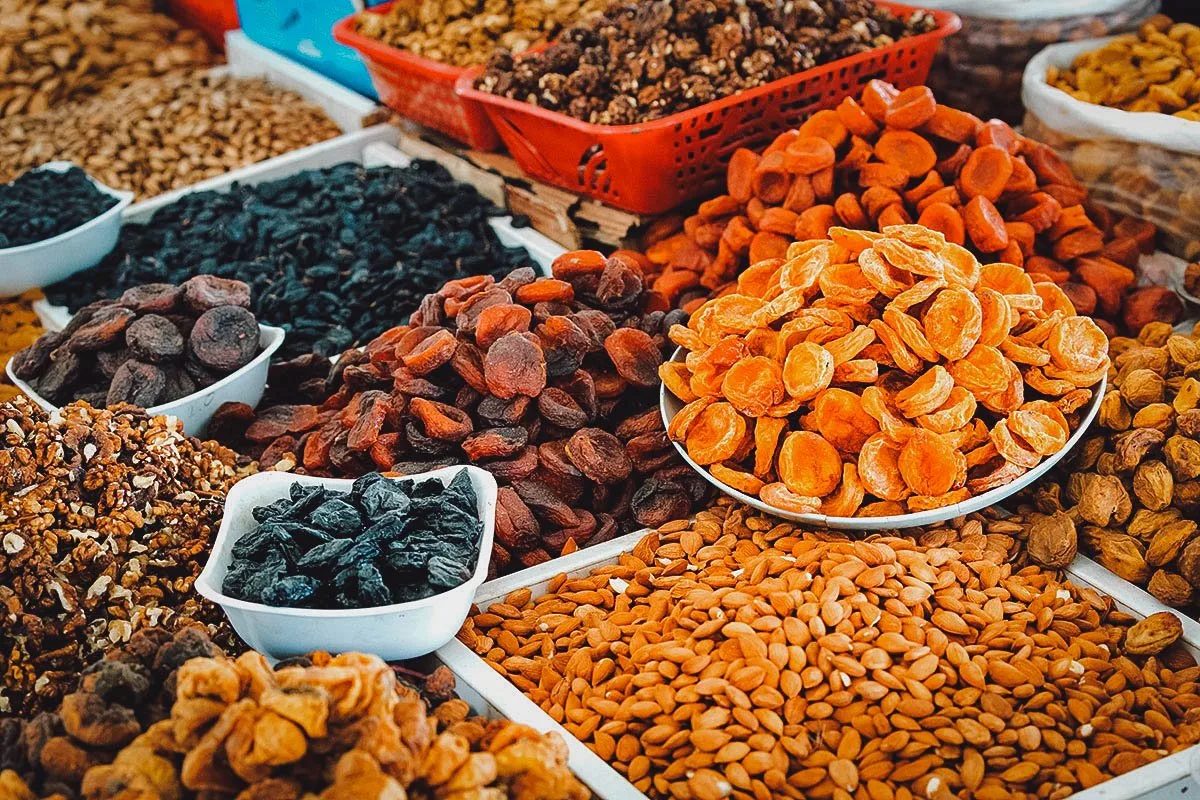
Photo by Curioso_Travel_Photography
FINAL THOUGHTS ON THE FOOD IN UZBEKISTAN
As with all our food guides, this article on Uzbek food is a work in progress. It includes some of the most important Uzbek dishes like plov, manti, and obi non, but conspicuously missing are examples of Bukharan Jewish cuisine and Uzbek sweets like khalva and navat.
This article will grow and improve with every update but we do hope it whets your appetite before your next trip to Uzbekistan and Central Asia. Thanks for reading and have an amazing time exploring the architecture and food in Uzbekistan!
Cover photo by kovalnadiya.ukr.net. Stock images via Depositphotos.


Jey
Tuesday 12th of April 2022
You need to stop calling asian origin dumplings 'italian version of or Russian versian' dumplings whatever you call them originated in Asia or Cebtral Asia. Italians Russians and the rest of the world know of dumplings from Asian and Turkish sources.
Lee
Monday 29th of January 2024
@Jey, do you really think that combining of dough with some filling (meat or vegetables) was so unbelievably complicated, that it could come to mind only in Asia?
JB & Renée
Tuesday 12th of April 2022
It's just a figure of speech Jey, to help others who've never tried or heard of it get a better understanding of the dish. Not everyone is as knowledgeable or privileged.